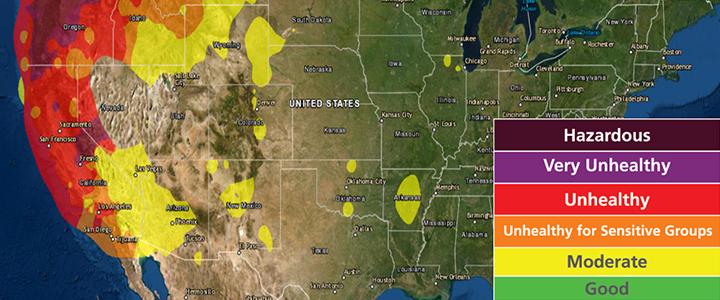
West Coast Wildfires and New Hampshire’s Air Quality
The summer and fall of 2020 has been a record-breaking season for wildfires on the west coast. California and Oregon have seen a constant barrage of wildfires starting in May and continuing into late September. National and international news outlets have shown apocalyptic images of orange skies and smoke so thick that it obscures views of iconic landmarks such as the Golden Gate Bridge in San Francisco.
In addition to causing devastating loss of life and property damage, these wildfires have exposed residents of the affected areas to dangerously high air pollution levels. Air pollution, especially fine particulate matter (particulate matter less than 2.5 microns, known as PM2.5), has been so high in those areas that it has surpassed the scale of EPA’s Air Quality Index (AQI). For example, the AQI map for September 14, 2020 shows air quality on the west coast reaching into the Very Unhealthy and Hazardous ranges and beyond. These air pollution levels are roughly comparable with those that have been observed in the cities of developing countries of China and India.
Although these wildfires have been occurring almost 3,000 miles away, they have been making themselves known in New Hampshire and the Northeast. Synoptic-scale weather patterns, which occur at continental, or even global, scales are capable of transporting air masses for hundreds, even thousands, of miles. Since prevailing winds in North America generally occur in a west to east pattern, smoke from the west coast wildfires has been transported across the country.
The wildfire smoke was a concern among air quality forecasters in the Northeast but thankfully the smoke generally remained aloft in the atmosphere, as is common for synoptic-scale transport patterns. Despite the hazardous air quality conditions in the directly affected areas, air quality in New Hampshire and the northeast region was not significantly impacted from a public health standpoint.
However, it is believed that the smoke did contribute to Moderate PM2.5 levels (meaning people who are unusually sensitive to air pollution should consider limiting prolonged exertion) in New Hampshire during the weekend of September 25th. Moderate PM2.5 levels were measured at most of New Hampshire’s PM2.5 monitors during that weekend. PM2.5 levels at the summit of Pack Monadnock (elevation approx. 2,280 feet above sea level) were even higher than the levels measured at ground-level monitors, which indicates the heavy presence of smoke aloft. The forecasting staff in the Air Resources Division accurately predicted this event and provided the appropriate health messaging to the public.
It is expected that any additional wildfire smoke from the West Coast will remain aloft and that its impact on New Hampshire’s air quality will continue to be relatively minor. Nevertheless, NHDES air quality forecasting staff will continue to track the wildfire smoke, as well as any other potential local or regional influences on New Hampshire’s air quality.




